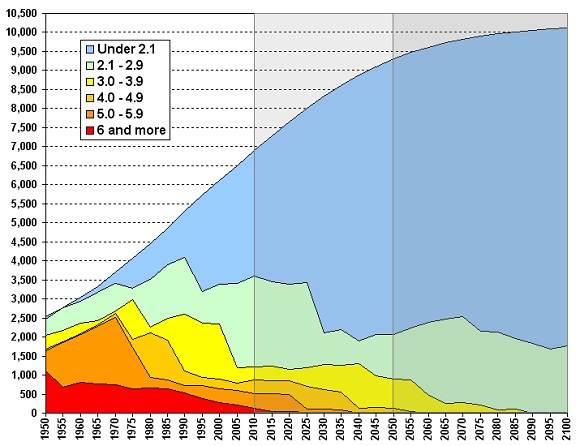Predicting peak cropland
Can we control our destiny?
by Liza Lester, ESA communications officer
Population by Total Fertility (millions). The United Nations predicts 10.1 billion living humans will inhabit the Earth by 2100. Source: United Nations, Department of Economic and Social Affairs, Population Division (2011): World Population Prospects: The 2010 Revision. New York.
Joe Fargione, lead scientist for The Nature Conservancy’s North American Region, wants to know how to feed 10 billion people. More specifically, he wants to know how much of the Earth’s land we will need to devote to crops to feed us all in the foreseeable future, for values of “foreseeable” converging on about one century hence. Ten billion and growing is the most recent UN global population projection for the year 2100. Fargione is a little more optimistic about reaching a population peak before the end of the century. Population has an intimate, complicated relationship to land use, and sparing wildlands from the plough is, of course, a topic close to TNC’s heart.
“We currently crop an area equivalent to all of South America,” (about 1.5 billion hectares) Fargione said, explaining his (as yet unpublished, as far as I can discover) efforts to model “peak cropland” at World Wildlife Fund headquarters in Washington, D.C., on February 28. “We don’t have another South America to put into production.”
As the human population continues to grow, and grow wealthier, more land will be converted to agriculture. But how much more, and when will it stop? Predicting peak cropland, the year when the greatest extent of Earth’s lands will be sown in crops, requires a metaprojection interpolating growth in population, food consumption, wealth, technology, and efficiency with the uncertain effects of a changing climate. How many humans we will be, and how much and what kinds of food we will eat? Will we grow until we reach carrying capacity and world population is checked by the hard limits of starvation, or can we control our destiny?
Fargione thinks it doesn’t have to come down to a Malthusian equation. He’s using predictions of a demographic transition from exponential population growth to static, stable numbers in the 21st century, counting on the non-compulsory drop in fertility observed in relatively wealthy nations to spread throughout the world. Japan and several European nations are currently below replacement rate (approximately 2.1 children per woman). Associated with the demographic transition is an uncertain tangle of influences: wealth, security, urbanization, and the education of girls. That last bit, the education of girls, is an angle Fargione thinks has been under appreciated and under emphasized by conservationists.
A projection of straight numbers of humans is not sufficient to predict food demand. As people gain ground on wealth and security, they tend to have fewer kids, but eat more food. How much meat will people eat? “The data for that doesn’t exist and if you tried to come up with it there would be too much uncertainty,” Fargione said. The work-around is to project forward the ratio of demand (kilocalories) to cropland (hectares) based on past trends. “The good news is, no matter how wealthy you are, there’s a limit to how much food you can stuff yourself with.”
Out of the thicket of estimates and uncertainties, Fargione produced an estimate placing peak cropland around midcentury, with another 42 million hectares in production (and an error range of +7mha to +104 mha). The forecast is sensitive to continued investment in yield improvements. If the rate of yield growth slows, he said, we could be looking at another 404 million hectares in production by 2076.
Biofuels add their own unpredictability to the forecast. “Projecting very far is foolish because biofuels are dependent on subsidies and mandates,” Fargione said, and politics are capricious. If we continue on the biofuel track, we could convert another 48 million hectares to biofuel stocks by 2035, which is a greater expansion of croplands than Fargione predicts we will need to feed everyone. “This is pretty scary to me,” he said. We devoted 2.2% of cropland (33.3 mha) to biofuels in 2008, contributing 1.7% of liquid fuels for transportation. “How much land are we willing to set aside for fuels? Because it can’t meet our demand.”
What happens when we get old really fast? Isn’t that bad? The Washington Post seems to think it’s a problem. “Old people aren’t what they used to be,” Fargione said, and when everyone laughed, added “It’s really true; there’s data to support it!” Old people are working longer. The right numbers, he said, include dependents on both ends of the age spectrum, and by this measure, he said the “dependency ratio” is falling. We have fewer kids. Kids are expensive and energy-intensive.
Can’t we fix demand by eating better, and eating less? Waste not, etc.? Fargione shook his head. There are a lot more former-vegetarians than there are vegetarians, he said. “I’m not optimistic.”
Further reading:
Fargione noted that Jesse Ausubel and colleagues sorta scooped him last December with an early release of a report on Rockefeller University’s webpage “Peak farmland and the prospect for land sparing,” asserting that we have already reached peak farmland. He said the group worked from near identical numbers and models. The discrepancy seems to be in an assumption by Ausubel et al of exponential growth in crop yields, and exclusion of biofuels. Fargione said that yields have been increasing linearly, and he expects them to continue so. Ausubel et al’s report will be published by Population and Development Review next year.
This March in Frontiers in Ecology and the Environment, John DeLong, Oskar Burger and Marcus Hamilton, explain in a peer-reviewed letter that they do not believe human population is approaching a stable equilibrium. The UN medium population projection is an unstable equilibrium. (2013) Frontiers in Ecology and the Environment 11:2, 65-66.
